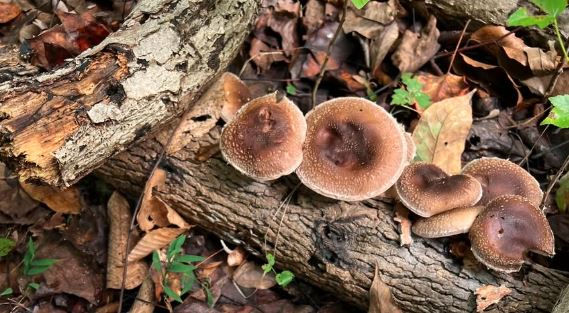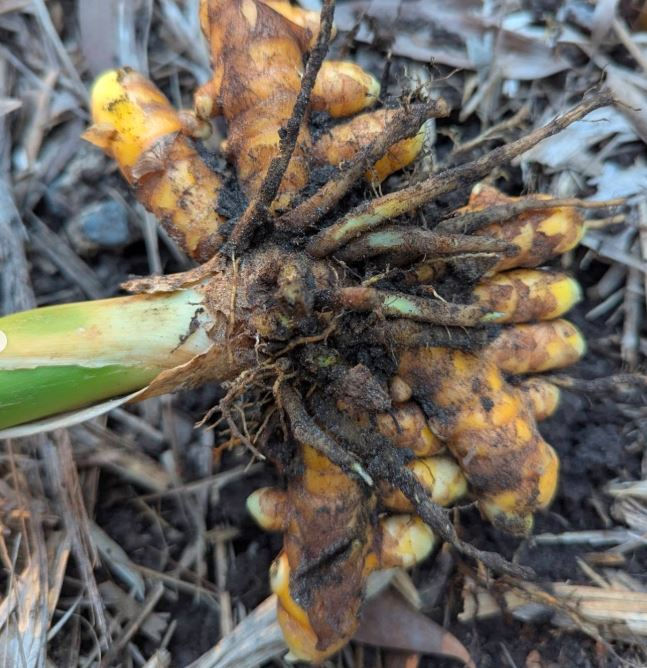Top 20 Most Profitable Crops to Grow Globally
- BeyondForest

- Nov 10
- 13 min read
Updated: Nov 12
Close-up of numerous brown, round Macadamia nuts
1.)About Saffron
2.)About Vanilla Beans
3.)About Macadamia Nuts
4.)About Blueberries
6.)About Mushrooms (Oyster & Shiitake)
7.)About Avocados (Hass)
8.)About Dragon Fruit
9.)About Lavender
11.)About Garlic
12.)About Ginger
13.)About Tomatoes
15.)About Hemp
17.)About Almonds
18.)About Tea
19.)About Coffee (Arabica
22.)Best Countries to Grow High-Value Crops
Saffron, often called the “golden spice,” is one of the most valuable and exotic spices in the world. It is derived from the dried stigmas of the Crocus sativus flower, which blooms only once a year for a short period. Each flower produces just three red threads, making saffron’s production extremely labor-intensive — around 75,000 flowers are needed to yield one pound of saffron. The spice is renowned for its rich golden-yellow color, distinct aroma, and subtle, earthy flavor with hints of honey and hay.
Saffron is widely used in culinary dishes such as biryani, paella, and risotto, and also in traditional sweets, teas, and herbal medicines. Beyond its culinary appeal, saffron contains powerful antioxidants like crocin, safranal, and picrocrocin, which have mood-boosting, anti-inflammatory, and potential anti-cancer properties. It is mainly cultivated in Iran, India (especially Kashmir), Spain, and Greece, where it’s cherished as a cultural and economic treasure.
About Vanilla Beans
Vanilla beans are the flavorful seed pods of the Vanilla planifolia orchid, one of the few orchids cultivated for agricultural purposes. Native to Mexico, vanilla is now grown mainly in Madagascar, Indonesia, Uganda, and Tahiti. Each vanilla bean is hand-pollinated, harvested when mature, and then cured and dried over several months—a meticulous process that gives the beans their rich aroma and complex flavor.
The beans are long, thin, and dark brown to black, filled with thousands of tiny seeds that contribute to their signature speckled look in desserts. Known for their sweet, creamy, and floral scent, vanilla beans are used in baking, ice cream, chocolates, perfumes, and beverages.
They contain vanillin, the main compound responsible for their flavor, though natural beans also have over 200 additional aromatic compounds, giving them depth that synthetic vanilla can’t replicate. Vanilla beans are prized worldwide, symbolizing luxury, craftsmanship, and natural purity.
About Macadamia Nuts
Macadamia nuts are rich, buttery nuts native to Australia but now widely cultivated in regions such as Kenya, South Africa, Hawaii, and Guatemala. They grow on evergreen trees (Macadamia integrifolia and Macadamia tetraphylla) and are prized for their delicate flavor, creamy texture, and high oil content. Each nut is encased in a hard, woody shell that requires specialized cracking tools to extract the kernel.
Macadamias are among the most nutritious nuts, packed with healthy monounsaturated fats, dietary fiber, and essential minerals like magnesium, iron, and potassium. They support heart health, improve cholesterol balance, and provide sustained energy. In culinary use, macadamia nuts are enjoyed raw, roasted, or incorporated into cookies, chocolates, salads, and nut butters.
Their oil is also valued in cosmetics for its moisturizing properties. Due to their slow tree maturity and labor-intensive harvesting, macadamia nuts command premium prices globally, making them a symbol of luxury and high-quality nutrition.

Blueberries are small, round, and vibrant blue-purple berries belonging to the Vaccinium genus, native to North America but now grown worldwide in temperate regions. They are celebrated as one of nature’s most powerful superfoods, packed with antioxidants—particularly anthocyanins that give them their deep color and numerous health benefits. Blueberries are rich in vitamins C and K, fiber, and manganese, supporting heart health, brain function, and immune strength.
Their sweet-tart flavor makes them versatile for use in smoothies, desserts, salads, and baked goods like muffins and pancakes. Beyond their culinary appeal, blueberries have been linked to improved memory, reduced inflammation, and lower risk of chronic diseases such as diabetes and hypertension. The berries grow on low, bushy shrubs and thrive in acidic, well-drained soils. Fresh, dried, or frozen, blueberries remain a staple of healthy diets worldwide, cherished for their taste, nutrition, and vibrant color.
About Truffles
Truffles are rare, highly prized fungi that grow underground in symbiosis with the roots of certain trees, such as oaks and hazelnuts. Belonging to the Tuber genus, truffles are renowned for their intense aroma and unique, earthy flavor that adds depth and luxury to gourmet dishes.
They are typically found in regions with temperate climates, especially France, Italy, and Spain, with varieties like black truffles (Tuber melanosporum) and white truffles (Tuber magnatum) being the most sought after. Because truffles grow beneath the soil, trained dogs or pigs are used to sniff them out during harvest season. Their cultivation and limited natural supply make them one of the most expensive foods in the world.
About Mushrooms (Oyster & Shiitake)
Shiitake mushrooms are Traditionally cultivated by inoculating logs with shiitake spawn and allowing them to colonize over several months.
Brown Shiitake mushrooms
Oyster and Shiitake mushrooms are two of the most popular edible fungi, cherished for their taste, nutrition, and culinary versatility. Oyster mushrooms (Pleurotus ostreatus) have soft, fan-shaped caps with a mild, delicate flavor and tender texture. They grow naturally on decaying wood and are also easy to cultivate on substrates like straw, making them a favorite among small-scale farmers. Shiitake mushrooms (Lentinula edodes), native to East Asia, have a rich, savory, umami flavor and a firm texture, widely used in Asian cuisines such as soups, stir-fries, and ramen.

Rows of oyster mushrooms by E&H Farms
Both types are nutrient-dense, offering protein, fiber, B vitamins, and essential minerals. They are also valued for their medicinal properties—especially Shiitake, which contains lentinan, known to boost immunity and support heart health. Whether sautéed, grilled, or dried, oyster and shiitake mushrooms enhance flavor and nutrition, making them indispensable in both traditional and gourmet dishes.
Hi, I’m Evans. Need Data Research or Analysis?
I help businesses gather the right data and turn it into actionable insights.
About Avocados (Hass)
Hass avocados are the most popular and widely cultivated avocado variety in the world, known for their rich flavor, creamy texture, and high nutritional value. Originating from California in the 1920s, the Hass variety is distinguished by its dark, pebbly skin that turns purplish-black when ripe. The fruit’s pale green flesh is buttery and slightly nutty, making it ideal for salads, guacamole, sandwiches, and smoothies.
Hass avocados are packed with healthy monounsaturated fats, particularly oleic acid, which supports heart health and helps regulate cholesterol levels. They also provide fiber, potassium, vitamins E, K, and B6, and antioxidants that promote glowing skin and overall wellness.
About Dragon Fruit
Dragon fruit, also known as pitaya or pitahaya, is an exotic tropical fruit derived from several cactus species, most notably Hylocereus undatus. It is easily recognized by its bright pink or yellow skin and unique scale-like texture resembling a dragon’s scales. The inner flesh—white, red, or purple depending on the variety—is dotted with tiny edible black seeds and offers a mildly sweet, refreshing flavor.
Rich in antioxidants such as vitamin C, betalains, and polyphenols, dragon fruit supports immunity, skin health, and digestion. It’s also low in calories and high in fiber, making it a popular choice for healthy diets.
The plant thrives in warm, semi-arid climates with well-drained soils and minimal rainfall, making it ideal for regions like Kenya’s coastal and eastern areas. Dragon fruit can be eaten fresh, blended into smoothies, or used in desserts and juices.
About Lavender

Lavender (Lavandula angustifolia) is a fragrant, evergreen herb native to the Mediterranean region and widely grown for its aromatic flowers and essential oils. Known for its soothing scent and striking purple blooms, lavender thrives in sunny, well-drained soils and can tolerate drought, making it ideal for semi-arid areas. Its essential oil is extracted through steam distillation and is valued for its calming, antiseptic, and anti-inflammatory properties.
Lavender is used in aromatherapy, cosmetics, perfumes, and natural remedies for stress relief, sleep improvement, and skin care. Dried lavender flowers are also used in sachets, teas, and culinary recipes for their delicate floral flavor. The plant’s ability to attract pollinators like bees adds ecological benefits, supporting biodiversity.
About Bamboo
Bamboo is a fast-growing, renewable grass species prized for its versatility, strength, and environmental benefits. There are over 1,500 species worldwide, with varieties such as Bambusa vulgaris and Dendrocalamus asper commonly grown in tropical regions like Kenya. Unlike trees, bamboo can mature in just 3–5 years and regrows after harvesting without replanting, making it a highly sustainable resource. Its sturdy, lightweight stems are used in construction, furniture, flooring, paper production, and handicrafts. Additionally, bamboo shoots are edible and highly nutritious.
Ecologically, bamboo helps prevent soil erosion, improves water retention, and absorbs large amounts of carbon dioxide, contributing to climate change mitigation. In Kenya and across Africa, bamboo farming is gaining popularity as a profitable venture due to rising demand for eco-friendly materials and export potential.
About Garlic
Garlic (Allium sativum) is a hardy, bulbous plant belonging to the onion family and is widely cultivated for its pungent flavor and powerful medicinal properties. Originating from Central Asia, garlic has been used for thousands of years in both cooking and traditional medicine. Each bulb is composed of multiple cloves enclosed in a papery skin, which when crushed or chopped releases allicin
A compound known for its antibacterial, antifungal, and immune-boosting effects. Garlic thrives in well-drained, fertile soils under cool to mild temperatures and requires minimal maintenance, making it a profitable crop for small farmers. In the kitchen, it is an essential spice that enhances the flavor of countless dishes across global cuisines. Beyond its culinary appeal, garlic is valued for promoting heart health, reducing blood pressure, and improving cholesterol levels. Its long shelf life and high demand make it one of the most marketable and rewarding crops to grow.
About Ginger
Ginger (Zingiber officinale) is a tropical, aromatic root crop widely valued for its culinary, medicinal, and industrial uses. Native to Southeast Asia, ginger is now cultivated across the world, including in Kenya, India, and Nigeria. The rhizome—the underground stem—is the main edible part, recognized for its spicy, warming flavor and distinctive aroma. Ginger contains active compounds such as gingerol and shogaol, which possess anti-inflammatory, antioxidant, and digestive benefits. It’s commonly used in teas, curries, sauces, baked goods, and beverages, and also serves as a natural remedy for nausea, colds, and muscle pain.
The plant thrives in warm, humid climates with well-drained loamy soils rich in organic matter. It matures in 8–10 months after planting, yielding both fresh and dried forms for local consumption or export. As global demand for natural health products rises, ginger remains a highly profitable crop due to its versatility, long shelf life, and medicinal value.
About Tomatoes
successful production requires careful management of pests, diseases, and irrigation.
Tomatoes (Solanum lycopersicum) are one of the most widely cultivated and consumed vegetables in the world, valued for their flavor, nutrition, and versatility. Originating from South America, tomatoes thrive in warm, sunny climates with well-drained soils rich in organic matter. They are grown in both open fields and greenhouses, allowing for year-round production. Tomatoes are packed with vitamins A, C, and K, potassium, and antioxidants—especially lycopene, which is known for its heart health and anti-cancer benefits.
Tomatoes come in many varieties, including cherry, plum, and beefsteak, suited for different culinary uses such as sauces, salads, soups, and juices. Economically, tomatoes are a high-demand crop with strong local and export markets, making them profitable for both small and large-scale farmers.
About Chia Seeds

Chia seeds come from the Salvia hispanica plant, a flowering species native to Central and South America, and are celebrated as one of the most nutrient-dense superfoods in the world. These tiny black or white seeds are rich in omega-3 fatty acids, protein, fiber, calcium, magnesium, and antioxidants.
When soaked in water or milk, they form a gel-like texture due to their high soluble fiber content, making them ideal for smoothies, puddings, and baked goods. Chia seeds promote heart health, improve digestion, and help regulate blood sugar levels. They thrive in well-drained, fertile soils under warm, sunny conditions with moderate rainfall.
About Hemp
Hemp (Cannabis sativa) is an ancient, highly versatile crop cultivated for its fiber, seeds, and oil, distinct from marijuana due to its minimal THC content (less than 0.3%). It grows rapidly—maturing within 90 to 120 days—and thrives in well-drained, nutrient-rich soils with moderate rainfall. Hemp’s strong, lightweight fibers are used in textiles, ropes, paper, construction materials, and eco-friendly packaging, while its seeds produce nutritious oil rich in omega-3, omega-6, and protein.
The plant also improves soil fertility through phytoremediation, absorbing toxins and carbon dioxide, making it a sustainable choice for regenerative agriculture. Hemp’s byproducts are used in cosmetics, food supplements, and animal feed, creating multiple revenue streams. Globally, countries like China, Canada, and the U.S. are leading producers due to its high market value and diverse applications.
Goji berries (Lycium barbarum), also known as wolfberries, are bright red-orange fruits native to China and parts of Tibet, celebrated for their impressive nutritional and medicinal properties. These small, sweet-tart berries are packed with antioxidants, particularly zeaxanthin, which supports eye health and protects against cellular damage. They are also rich in vitamins A and C, iron, fiber, and essential amino acids, making them a powerful superfood. Traditionally used in Chinese medicine, goji berries are believed to boost immunity, improve skin health, and enhance energy levels.
Goji Berries plants thrive in well-drained, slightly alkaline soils and sunny climates, tolerating both drought and cold. Goji berries can be eaten fresh, dried, or blended into teas, juices, and smoothies. With rising global demand for natural wellness products, goji berry farming has become profitable in countries like China, the U.S., and Kenya.
The global almond industry continues to grow due to increasing demand for plant-based and gluten-free products.

Almonds (Prunus dulcis) are nutrient-rich tree nuts native to the Middle East but now extensively cultivated in regions like California, Spain, and Australia. The almond tree thrives in warm, Mediterranean-type climates with mild winters and dry summers, requiring well-drained soils and efficient irrigation.

Almonds are prized for their crunchy texture, delicate flavor, and exceptional nutritional value. They are an excellent source of protein, healthy monounsaturated fats, vitamin E, magnesium, and antioxidants that promote heart health, brain function, and glowing skin. Consumed raw, roasted, or processed into almond milk, flour, and butter, they are staples in both traditional and modern diets.
About Tea

Tea (Camellia sinensis) is one of the world’s most widely consumed beverages, valued for its refreshing taste, cultural significance, and health benefits. Originating from China, tea is now grown in tropical and subtropical regions, with Kenya, India, Sri Lanka, and China being leading producers.
The type of tea—green, black, oolong, or white—depends on how the leaves are processed after harvesting. Tea plants thrive in high-altitude areas with well-drained, acidic soils and consistent rainfall. Rich in antioxidants such as catechins and polyphenols, tea helps improve heart health, boost metabolism, and reduce stress. Beyond its health appeal, tea is a major export commodity that supports millions of livelihoods globally.
Major producers include Brazil, Colombia, Ethiopia, and Kenya
Arabica coffee (Coffea arabica) is the most popular and high-quality coffee species in the world, prized for its smooth flavor, aromatic complexity, and mild acidity. Originating from the highlands of Ethiopia, Arabica thrives best in cool tropical climates at altitudes between 1,000 and 2,000 meters above sea level. It prefers rich, well-drained volcanic soils, moderate rainfall, and shaded conditions.
The beans are oval-shaped with a distinctive curved crease, producing a refined taste often described as fruity, floral, or nutty, depending on the growing region. Arabica contains less caffeine than Robusta, making it smoother and more aromatic.
About Herbs (Basil, Mint, Rosemary)
Basil (Ocimum basilicum) is a tender annual herb native to tropical Asia and Africa, famous for its sweet aroma and vibrant green leaves. It thrives in warm, sunny conditions and well-drained soils. Basil is a staple in Mediterranean and Asian cuisines, used in sauces, salads, and pestos. Medicinally, it is valued for its anti-inflammatory and antioxidant properties, promoting digestion and immune health.
Mint (Mentha spp.) is a hardy perennial herb that spreads quickly through underground rhizomes. It prefers moist, partially shaded areas and grows well in both pots and open fields. Mint’s refreshing flavor and cooling effect make it popular in teas, desserts, and beverages. It also aids in digestion, relieves nausea, and provides natural relief for respiratory congestion.

Rosemary (Rosmarinus officinalis) is an evergreen shrub native to the Mediterranean. It flourishes in dry, sunny environments and well-drained, slightly alkaline soils. With its strong, pine-like fragrance, rosemary enhances meats, breads, and soups, while its essential oil is valued in aromatherapy and skincare.
Several factors determine a crop’s profitability, starting with market demand crops with consistent or growing consumer demand fetch better prices. Production costs such as seeds, fertilizers, labor, and irrigation must be low relative to the selling price for good margins.
Yield per acre and input efficiency greatly influence returns, while climate suitability ensures stable production with fewer losses. Access to markets and reliable buyers also affect profits, as does value addition through processing or packaging. Lastly, government policies, pest and disease resistance, and proper timing of planting and harvest can significantly enhance overall profitability and sustainability.

Image of a Smiling man holds tomatoes by Santosh Jadhav
The best countries to grow high-value crops are those with favorable climates, fertile soils, and strong agricultural infrastructure. Nations like Kenya, Ethiopia, and South Africa in Africa excel in producing avocados, macadamia nuts, and flowers. India and Thailand lead in spices such as ginger and turmeric, while Vietnam and Indonesia dominate in coffee and pepper. Spain, Italy, and France thrive in olives, grapes, and lavender due to their Mediterranean climates. Peru and Mexico are major exporters of asparagus and avocados. These countries benefit from diverse agro-ecological zones, skilled labor, and expanding export markets that make high-value crop farming highly profitable.
Common Mistakes Farmers Make When Choosing Crops
Sound planning, data-driven decisions, and understanding local market dynamics are essential for profitable farming.
Many farmers make costly mistakes when choosing crops, often driven by trends rather than research.
A common error is ignoring market demand, leading to oversupply and low prices.
Others fail to assess soil type, climate, and water availability, resulting in poor yields.
Some farmers overestimate profits without calculating production costs or access to buyers.
Lack of crop rotation and overdependence on one crop can also deplete soil nutrients and increase pest risks.
Additionally, using uncertified seeds, neglecting extension advice, and poor record-keeping limit long-term success.
What is the most profitable crop to grow in the world?
Saffron is widely considered the most profitable crop globally, earning up to thousands of dollars per kilogram. However, it requires careful handling and specific climate conditions.
Which crops give the highest returns on small land?
High-value crops suitable for small spaces include mushrooms, herbs (basil, mint), ginger, garlic, and specialty greens. They grow fast and have strong domestic and export demand.
What crops are easiest to grow but still profitable?
Garlic, ginger, basil, lettuce, tomatoes (greenhouse), and dragon fruit are easy to grow while delivering excellent profit margins.
Avocados, bamboo, ginger, chili peppers, dragon fruit, macadamia nuts, and medicinal herbs thrive in warm regions and have strong market prices.
What crops have the highest international demand in 2025?
Top global demand crops include blueberries, avocados, garlic, ginger, chia seeds, specialty coffee, and medicinal herbs driven by health and wellness trends.
Are high-value crops risky to grow?
Some can be risky due to climate sensitivity, long maturity periods (like vanilla or macadamia), or complex market logistics. Conducting market research reduces risk.
Which crops are best for greenhouse farming?
Tomatoes, strawberries, peppers, cucumbers, lettuce, and mushrooms perform exceptionally well in controlled environments and offer year-round profits.
What crops can I export easily from Africa or Asia?
Avocados, ginger, garlic, spices, herbs, chia seeds, and specialty coffee have strong export markets in Europe, the Middle East, and Asia.
How do I choose the right profitable crop for my region?
Consider climate, water availability, soil conditions, market access, labor needs, and your ability to manage long-term crops versus quick-return crops.
Herbs like basil and mint, leafy greens, oyster mushrooms, and microgreens are among the fastest crops—some ready in 3–6 weeks with great profit margins.














































Comments